GO TO: PROGRAMS FOR NOXIOUS WEED CONTROL, BIOLOGICAL CONTROL, NOXIOUS WEEDS ENFORCEMENT, ANNUAL NOXIOUS WEED SURVEYS, RELATED EVENTS, NORTH DAKOTA NOXIOUS WEEDS, RELATED RESOURCES
North Dakota Law (NDCC § 4.1-47-02) requires every person to do all things necessary and proper to control the spread of noxious weeds. The North Dakota Department of Agriculture coordinates the efforts of county and city weed boards and state and federal land managers to implement integrated weed management programs.
PROGRAMS FOR NOXIOUS WEED CONTROL
Landowner Assistance Program (LAP)
The Landowner Assistance Program (LAP) provides weed boards with cost-share assistance for noxious weed control. To be eligible to receive LAP funds, weed boards must levy at least 3 mills for noxious weed control, or budget an amount equal to the revenue that could be raised by a levy of three mills. Historically, a majority of weed boards have used these funds to provide landowners with herbicide cost-share assistance. Eligible county and city weed boards are responsible for developing a LAP cost-share program for their areas.
Targeted Assistance Grant (TAG)
The Targeted Assistance Grant (TAG) program targets noxious weed control needs and provides a cost-share opportunity to county and city weed boards to meet those needs. TAG proposals describe a noxious weed problem within the county or city weed board's jurisdiction and proposes a management strategy.
The North Dakota Weed Seed Free Forage Program is a voluntary program in which producers may choose to have forage acreage inspected in order to use or sell forage as certified weed seed free forage or mulch.
BIOLOGICAL CONTROL
NOXIOUS WEEDS ENFORCEMENT
North Dakota's Noxious Weed Laws & Regulations
Enforcement Flow Chart
Enforcement Manual
ANNUAL NOXIOUS WEED SURVEYS
RELATED EVENTS:
Jan. 6, 2026 - Noxious Weed Forum - Bismarck Hotel
NORTH DAKOTA NOXIOUS WEEDS
Absinth Wormwood (Artemisia absinthium L.). )
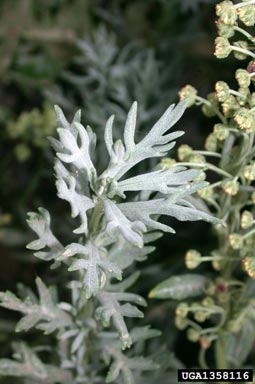
Identification:
Absinth wormwood is a perennial fragrant forb or herb. The plant commonly grows 3 to 5 feet tall at maturity. Absinth wormwood is woody at the base and regrows from the soil level each spring from a large taproot. Leaves are light to olive green, 2 to 5 inches long and divided two or three times into deeply lobed leaflets. Leaves and stems are covered with fine, silky hairs that give the plant a grayish appearance. Flower stalks appear at each upper leaf node and produce numerous yellow flower heads 1/8 inch in diameter, which appear from late July through mid-August in North Dakota. Each fruit contains one seed, which is less than 1/16 inch long, smooth, flattened and light graybrown.
Biological control:
No biological control agents or pathogens are available for this weed.
From Lym and Travnicek, 2015, NDSU Circ. W-1411.
Related Resource
Canada Thistle (Cirsium arvense (L.) Scop. )
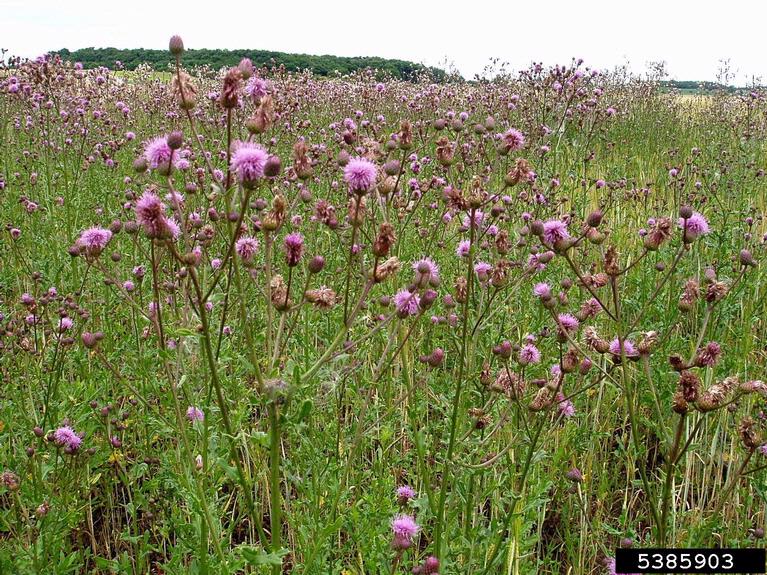
Identification:
Canada thistle is a long-lived perennial that usually grows 2 to 3 feet tall and bears alternate, dark green leaves that vary in size. The leaves are oblong, usually deeply cut, and have spiny, toothed edges. Canada thistle has small (3/4 inch diameter), compact flower heads that appear on the upper stems.
Canada thistle has been classified into several varieties. Within these varieties are many ecotypes, which differ in growth characteristics, response to day length, and susceptibility to herbicides and cultivation. For example, leaf shape, head structure, and the number and size of spines can differ with ecotypes. Canada thistle requires a 14- to 16- hour photoperiod to bolt and flower (April 19 to Aug. 22 in North Dakota). Flower color can range from purple to light lavender or even white. Stem color also can differ from green to lavender.
Flowering occurs from June to September. Male and female flowers are produced on different plants, so cross-pollination is necessary for seed production. Flowers produce from 40 to 80 seeds per head, which can move long distances, although most seed remain in the head until winter and eventually germinate nearby.
The smooth, light brown seeds (achenes) have a conical point and are loosely attached to a tannish pappus at the tip, which aids in seed dispersal by wind. Seeds mature rapidly and are able to germinate within eight to 10 days after pollination. Canada thistle overwinters in the rosette growth stage.
Canada thistle has an extensive underground root system that may penetrate the soil to a depth of 10 feet or more and grow laterally 12 to 15 feet per year. Root buds occur randomly along the roots and initiate new shoots whenever environmental conditions are favorable. Root segments as small as 0.6 inch can initiate shoot growth and become established.
Biological control:
Two biological control agents have been introduced for Canada thistle control, and a third was introduced accidentally. To date, none have been effective at reducing the weed on a large scale. The most widespread insect is Hadroplontus litura weevil, which first was released in North Dakota in the 1970s. The larvae feed on the underground parts of Canada thistle for a short time but infestations generally are not reduced. One may take advantage of the early season stress on Canada thistle from H. litura feeding by using additional control methods such as mowing or applying herbicides. In addition, natural soil pathogens may become more destructive due to multiple entry sites established by the insect. However, do not expect these insects alone to reduce a Canada thistle infestation.
A gall-producing fly, Urophora cardui, causes meristematic galls but does little long-term damage to the perennial thistle. The Canada thistle bud weevil, Larinus planus, was an accidental introduction into North America and is not permitted for distribution. The insect feeds on developing flowers to prevent seed production. Although L. planus can survive under a wide range of climates, it has not reduced established Canada thistle stands.
The painted lady butterfly (Vanessa cardui) can be a very effective biological control agent but only on an intermittent basis. Larvae of the butterfly feed on Canada thistle plants and can eliminate an infestation. However, the insect generally is found only in southern states such as Arizona and New Mexico and will build up populations large enough to migrate north only once every eight to 11 years. The insect will migrate north as far as Canada and those fortunate enough to reside within the migratory pathway will see a dramatic decrease in the Canada thistle population. Unfortunately, the insect feeds on many plants, including crops such as soybean and sunflower, and is not a candidate for long-term biological control of Canada thistle.
A native pathogen, Pseudomonas syringae pv. tagetis (Pst), causes the top of Canada thistle plants to turn yellow to white. This pathogen may release a toxin into the phloem of Canada thistle and kill the plant. The pathogen is most widespread during wet periods. Attempts to produce this pathogen as a commercial biocide have not been successful. Research is also being conducted on a native rust (Puccinia punctiformis) for Canada thistle control.
From Lym and Travnicek, 2015, NDSU Circ. W-1411.
Related Resource
Dalmatian Toadflax (Linaria genistifolia spp. dalmatica)
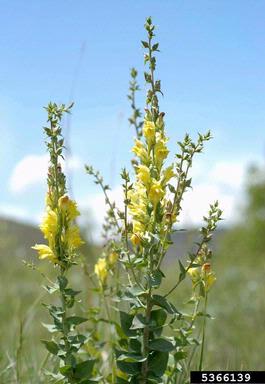
Photo by K. George Beck and James Sebastian, Colorado State University, Bugwood.org
Identification:
Dalmatian toadflax is a member of the snapdragon family and thus easily recognizable by the bright yellow flowers, which have swollen corolla tubes that flare into two “lips” and long spur. The flowers are 1 to 1.5 inches long with many flowers on a raceme. The plants have an extensive creeping rhizomatous root system that spreads like leafy spurge. Dalmatian toadflax has broad, heart-shaped leaves that clasp a woody stem.
The plants begin regrowth from the roots as soon as the soil warms in early spring. Toadflax flowers from late June through August in North Dakota and single plants may produce more than 500,000 seeds that are dispersed by wind, rain, wildlife, and movement of forage and livestock. The seed is disk-shaped, 0.08 inch in diameter and dark brown to black, and often have irregular papery wings. Seed dispersal begins a few weeks after flowering and continues into winter. The roots of a single plant can extend 10 feet and give rise to daughter plants every few inches.
Biological control:
The stem-boring weevil Mecinus janthiniformis has been the most successful and can reduce Dalmatian toadflax stands relatively quickly. M. janthiniformis larvae mine in Dalmatian toadflax stems, which slowly causes the plants to wilt and die.
From Lym and Travnicek, 2015, NDSU Circ. W-1411.
Related Resource
Diffuse Knapweed (Centaurea diffusa Lam.)
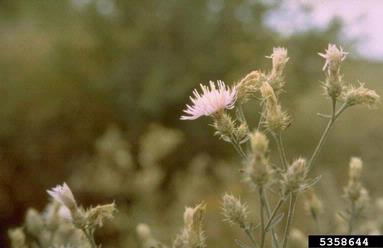
Identification:
Diffuse knapweed is a short-lived perennial or sometimes biennial plant reproducing solely by seed. Seed remains viable in the soil five years or more, so infestations may occur a number of years after vegetative plants have been eliminated. The seeds can germinate from spring through early fall. Seedlings emerging in the fall often overwinter as a rosette of leaves, resuming growth again in the spring. The plants grow 2 to 4 feet tall with one or more stems. The leaves are pale green and 3 to 4 inches long. Rosette leaves are deeply lobed. Plants flower from early July through August and produce 1,000 or more seeds per plant. Diffuse knapweed has a rigid terminal spine about one-third of an inch long with four to five pairs of shorter, lateral spines (crablike). The plants have pink to light purple and occasionally white flowers.
Biological control:
In general, the knapweed infestations are small enough that herbicide and hand removal are the best and most cost-effective treatments in North Dakota. Biological control agents have been introduced in neighboring states to control spotted knapweed. There are 13 biological control agents currently permitted for use against knapweed species. Consult the N.D. Dept. of Agriculture or NDSU weed specialists for the latest information on which agents may be successful in the state.
From Lym and Travnicek, 2015, NDSU Circ. W-1411.
Related Resource
Leafy Spurge (Euphorbia esula L.)
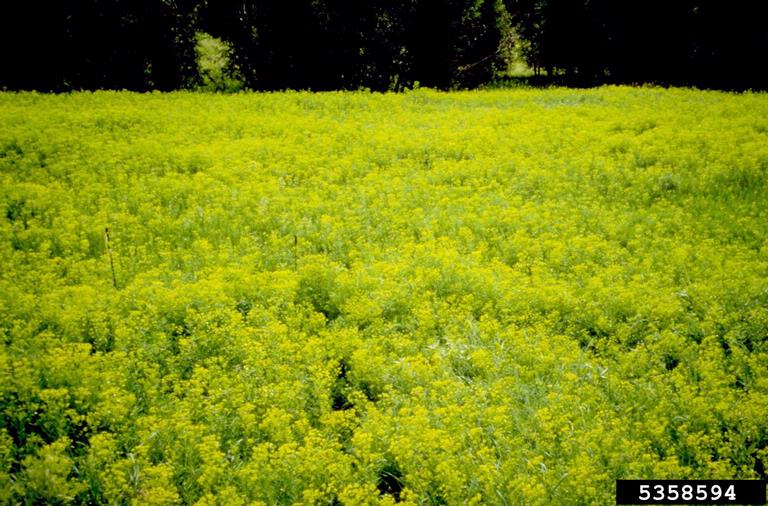
Identification:
Leafy spurge is a long-lived perennial that normally grows 2 to 3 feet tall from a woody crown from below the soil surface. Each crown area produces several upright stems, giving the plant a clumplike appearance. The plant bears numerous linear-shaped leaves with smooth margins. The leaves have a characteristic bluish-green color but turn yellow or reddish orange in the fall. Stems originating from crown buds and roots begin growth in late April, making leafy spurge one of the first plants to emerge in the spring. The early and rapid growth gives leafy spurge a competitive advantage over crop and pasture plants. All parts of the plant contain a milky juice called latex, which is a useful identifying characteristic.
Leafy spurge produces a flat-topped cluster of yellowishgreen petal-like structures called bracts, which surround the true flowers. The showy, yellow bracts appear in late May and early June, giving the plant the appearance of “blooming.” However, the true flowers, which are small and green, do not develop until mid-June.
Seeds are borne in pods, which contain three gray-brown, oblong, smooth seeds. After the seed has matured, the seed pods burst explosively and throw seeds up to 15 feet from the parent plant. An average of 140 seeds is produced per stem, and seeds may remain viable in the soil at least eight years.
The root system of leafy spurge is extensive and consists of numerous coarse and fine roots that occupy a large volume of soil. Roots are most abundant in the upper foot of soil, but some roots can extend to a depth of 15 feet or more. The roots are woody and durable in structure, with numerous buds capable of producing new shoots.
Biological control:
Biological control of leafy spurge was initiated in the mid-1980s. To date, 10 species of insects have been released in North Dakota for control of leafy spurge, and six have become established. Four of the six established insects are flea beetles (Aphthona spp.), which have reduced the leafy spurge density more than any other agent.
The first flea beetle released in North Dakota was Aphthona flava Guill in 1986. This flea beetle has established at only a few sites in the state and occurs at densities too low to be effective. In 1988, a mixed population of Aphthona czwalinae Weise and Aphthona lacertosa Rosenhauer were released near Valley City, N.D. By 1995, the majority (greater than 90 percent) of this mixed population was A. lacertosa. Two additional flea beetles, Aphthona cyparissiae Koch and Aphthona nigriscutis Foudras, were released the following year. A. lacertosa and A. nigriscutis were established in almost every county in North Dakota by 1996 and have become the major biocontrol agents used for leafy spurge control.
Although Aphthona spp. adults feed on leafy spurge foliage, the major damage to the plant occurs when the larvae feed on the roots. Larvae feed on both the fine feeder roots used by the plant to absorb water and nutrients and the storage tissue of the root crown. This feeding both destroys root tissue directly and causes the plant to be more susceptible to other methods of control, such as herbicides and infection from soil borne pathogens.
Research at North Dakota State University found flea beetle establishment was best on silt loam, silt clay loam, clay loam and clay soils with an organic matter content of 6 percent to 9.5 percent. Flea beetles were least productive in fine sand to loamy fine sand soils with an organic matter content of 1 percent to 3 percent. In addition, the release area needs to be well-drained and not subject to frequent prolonged flooding or standing water, which will kill the larvae. Generally, flea beetles have not been very successful in controlling leafy spurge growing along waterways, in shaded areas or in very sandy soil.
The Spurgia esulae gall midge causes stem tip galls on leafy spurge, thereby decreasing seed production. It has been most successful near wooded areas. However, a second control method was needed to reduce the original leafy spurge infestation and to prevent spread from roots. A stem-boring beetle, Oberea erythrocephala Shrank, has been released and established in North Dakota in the 1980s, but to date, the population never has increased to sufficient numbers to decrease leafy spurge. The spurge hawkmoth (Hyles euphorbiae L.), a foliar feeder, was introduced in the 1970s but generally has not survived and when it did survive, control was too late in the growing season to be very useful.
From Lym and Travnicek, 2015, NDSU Circ. W-1411.
Related Resource
Musk Thistle (Carduus nutans L.)
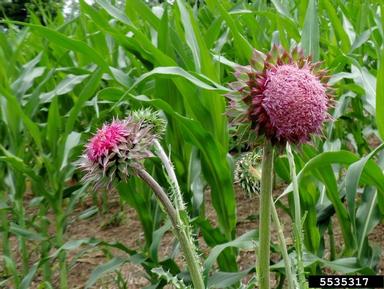
Identification:
Musk thistle likely is the most easily identified invasive thistle in North Dakota, yet many people confuse this plant with either bull thistle or plumeless thistle. Musk thistle often grows in excess of 6 feet tall, has very large flowers that tend to droop, and the flower has very characteristic brown bracts that resemble a pine cone. The flowers usually are deep rose, solitary and very large, ranging from 1.5 to 3 inches in diameter. Rosettes are dark green with a light green midrib, usually smooth and lacking pubescence and often grow 2 feet or more in diameter.
Musk thistle stems are usually very branched with spiny wings; however, the wings are interrupted and not complete along the stem as with bull or plumeless thistle. The leaves are oblong to lanceolate and lobed with slender spines along the margin. They generally have little pubescence underneath, which helps distinguish musk thistle from plumeless thistle. However, the subspecies C. nutans macrocephalus (Desf.) has very pubescent leaves.
Biological control:
The seed weevil Rhinocyllus conicus was introduced from Eurasia to control musk thistle by reducing seed production. Larvae develop in the flower head and consume the seed as it develops. The weevils can reduce seed production by nearly 80 percent, but they are attracted more to earlier blooming rather than to later blooming flowers. The late-season flowers produce seeds with little damage from the weevil, which sustains the musk thistle population. Building a high enough population of insects to greatly reduce seed production takes five to 10 years. These insects first were introduced into North Dakota in the early 1970s. R. conicus is not specific to musk thistle and has been found feeding on other invasive thistles, such as Canada thistle. However, this insect also feeds on native thistles, including several that are on the protected or endangered species list and interstate transport is not permitted.
The thistle crown weevil (Trichosirocalus horridus) was introduced into North America from Europe in the mid-1970s. Larvae of this insect feed on the growing tip as the musk thistle rosette bolts. While seldom effective by itself, it does help control musk thistle when combined with Rhinocyllus conicus. Feeding by T. horridus larvae on musk thistle growing tips causes the plant to produce multiple shoots. The resulting flower heads are reduced in size and produce fewer seeds, and the increased number of flower heads results in an increased population of R. conicus. Interstate transport of T. horridus is no longer permitted.
From Lym and Travnicek, 2015, NDSU Circ. W-1411.
Related Resource
Palmer amaranth (Amaranthus palmeri)
Click links below for information on identifying and reporting Palmer amaranth (PA).
How to Identify Palmer Amaranth - NDSU identify PA website
Palmer Amaranth Identification - Petiole (leaf stem is longer than the leaf)
Click Here to report Palmer Amaranth
Click Here for a map of affected areas.
If suspected Palmer plants are found:
- Landowners should scout fields starting in late spring through summer and fall, especially before harvest.
- When a suspicious plant is found, contact your county weed officer.
- Mark/flag the location and leave the plant in place in order to not spread seed. It is also easier to identify if it hasn’t been pulled.
- Take photos, photo quality will make it easier for plant identification. For example, take photos of leaves, stems and flowering structure on separate pictures compared with trying to get the entire plant in one photo. Generally, a specialist will travel to the site if it is deemed likely to be Palmer.
- The county weed officer will:
- Gather images and documentation to send to a weed specialist(s) for confirmation or for ruling out Palmer.
- Develop an action plan if Palmer is confirmed.
- Landowners should hand pull, bag on site and destroy confirmed Palmer plants.
- Palmer plants should be burned or deeply buried to prevent movement of seed.
- Landowners should work with their county weed officer and continue to survey the field for a period of 3-5 years post removal to verify no additional Palmer is found.
Contact Links:
- County weed officers (under Related Resources at bottom of page): https://www.ndda.nd.gov/divisions/plant-industries/noxious-weeds
- North Dakota Department of Agriculture:(Samantha McGrath, 701-328-2250, srmcgrath@nd.gov)
Genetic testing link:
- National Agricultural Genotyping Center (Fargo, ND):
Purple Loosestrife (Lythrum salicaria L., Lythrum virgatum L., and all cultivars)
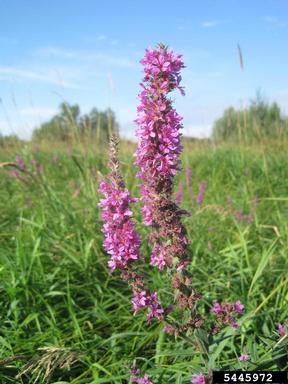
Identification:
Purple loosestrife is a rhizomatous perennial forb. Wild infestations are associated with moist or marshy sites. The stems are erect (1.5 to 8 or more feet tall) and four to six angled, and can be smooth or pubescent with few branches. Leaves are simple (0.75 to 4 inches long, 0.2 to 0.5 inch wide), entire, and can be opposite or whorled.
The most identifiable characteristic of purple loosestrife is the striking rose to purple flowers. The flowers are arranged on a spike, which can be a few inches to 3 feet long. Each flower has five to seven petals arising from a cylindrical green tube. The plant usually flowers from early July to mid-September in North Dakota. The seed capsule is two-celled and contains many very small seeds (1 millimeter long or less). The roots become thick and woody in mature plants. The aerial shoots die in the fall and new shoots arise the following spring from buds at the top of the root crown. Although the root crown expands and produces more shoots each year, the maximum growth of the root crown diameter is limited to about 20 inches.
Biological control:
Three biocontrol insect species first were released in North Dakota in 1997. They are:
Galerucella pusilla — a leaf-feeding beetle
Galerucella calmariensis — a leaf-feeding beetle
Hylobius transversovittatus — a root-mining weevil
Of these insects, the two Galerucella spp. leaf-feeding beetles have been most successful. These insects overwinter as adults and lay eggs in early June in North Dakota. The adults and especially the larvae feed on the leaves and flowers of purple loosestrife. Following several summers of heavy feeding, purple loosestrife infestations have been reduced greatly. However, since the largest infestations in North Dakota are in urban areas, mosquito control programs have kept these insects from becoming well established.
From Lym and Travnicek, 2015, NDSU Circ. W-1411.
Related Resource
Russian Knapweed (Centaurea repens L.)
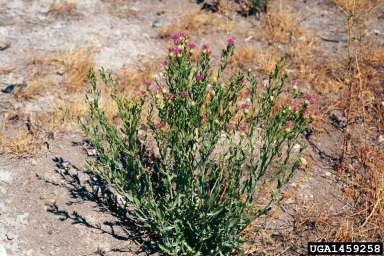
Identification:
Russian knapweed is a long-lived, deep-rooted perennial with growth characteristics similar to Canada thistle. The weed emerges in the spring from roots and grows to 2 to 3 feet tall and is shrublike with spreading branches. Once established, Russian knapweed spreads mainly by underground root stocks as seed production is limited compared with other knapweed species. The leaves are alternate and lobed lower on the plant while upper leaves are entire. Flowering occurs from June to September and flowers vary from light pink to lavender. The stems die back to the soil surface each year. Two key characteristics distinguish Russian knapweed from spotted and diffuse knapweed. First, the flowers have rounded bracts with transparent tips that are quite different in appearance than the dark bracts of spotted and diffuse knapweed. Second, the root of this perennial is dark brown to black, scaly as if the plant had been burned, and can grow to depths of greater than 20 feet. The flowers of Russian knapweed vary from light pink to lavender.
Biological control:
Exploration and evaluation of biocontrol agents for Russian knapweed are in progress. The gall fly Jaapiella ivannikovi was approved for release in 2009 has established and shows promise for the reduction of Russian knapweed. This insect may soon be available for wider distribution.
From Lym and Travnicek, 2015, NDSU Circ. W-1411.
Related Resource
Saltcedar (Tamarisk spp.)
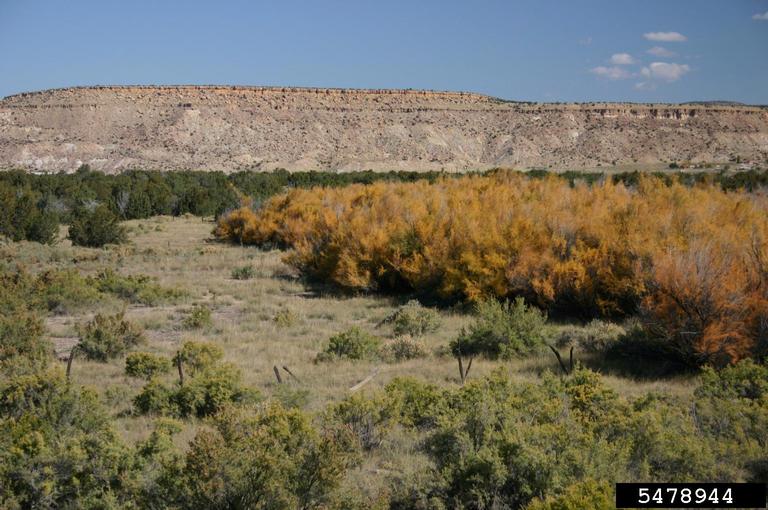
Identification:
Saltcedar is a shrubby bush or tree that can range in size from 5 to 20 feet tall. The bark is a reddish brown, especially on younger branches. The leaves are small and flat and resemble evergreen shrubs such as arborvitae. Flowers are pink to white and five-petaled, and appear from mid to late summer. The seeds are extremely tiny and similar in size and color to pepper. Each seed has a pappus, which allows it to float long distances in water or move in the wind. Seeds are short-lived and usually germinate within a few months after dispersal.
Biological control:
The leaf beetle Diorhabda carinulata defoliates the leaves of saltcedar. This insect feeds on the leaves of saltcedar and slowly reduces plant vigor. However, it has not been consistently successful in reducing saltcedar infestations. This insect has not been released in North Dakota because of the small size of the plants and low infestation level in the state.
From Lym and Travnicek, 2015, NDSU Circ. W-1411.
Related Resource
Spotted Knapweed (Centaurea maculosa Lam.)
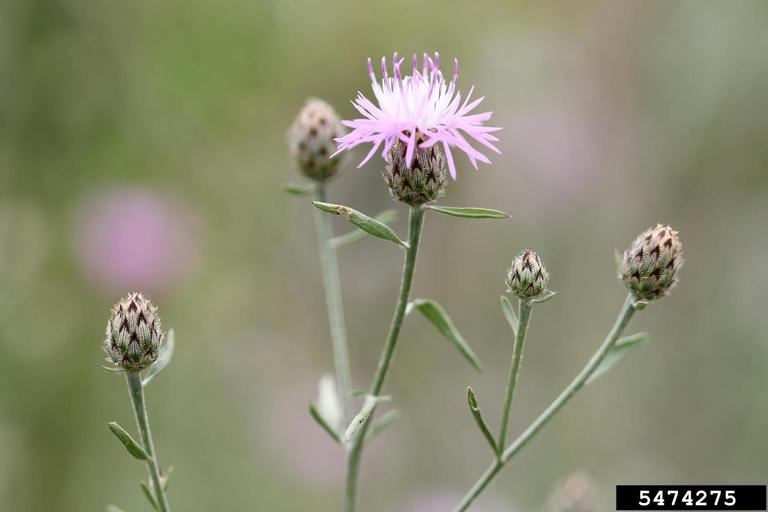
Identification:
Spotted knapweed is a short-lived perennial or sometimes biennial plant reproducing solely by seed. Seed remains viable in the soil five years or more, so infestations may occur a number of years after vegetative plants have been eliminated. The seeds can germinate from spring through early fall. Seedlings emerging in the fall often overwinter as a rosette of leaves, resuming growth again in the spring. The plants grow 2 to 4 feet tall with one or more stems. The leaves are pale green and 3 to 4 inches long. Rosette leaves are deeply lobed. Plants flower from early July through August and produce 1,000 or more seeds per plant. Spotted knapweed has stiff, black-tipped bracts. The plants have pink to light purple and occasionally white flowers.
Biological control:
In general, the knapweed infestations are small enough that herbicide and hand removal are the best and most cost-effective treatments in North Dakota. Biological control agents have been introduced in neighboring states to control spotted knapweed. There are 13 biological control agents currently permitted for use against knapweed species. Consult the N.D. Dept. of Agriculture or NDSU weed specialists for the latest information on which agents may be successful in the state.
From Lym and Travnicek, 2015, NDSU Circ. W-1411.
Related Resource
Yellow Toadflax (Linaria vulgaris)
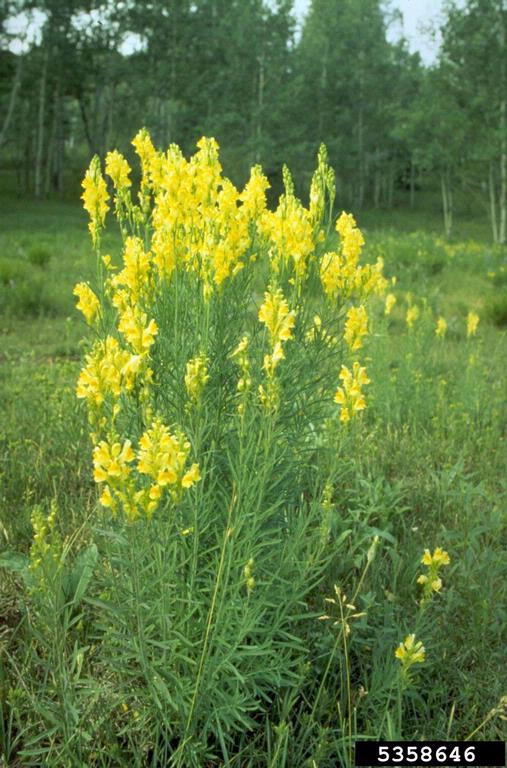
Identification:
Yellow toadflax is a member of the snapdragon family and thus easily recognizable by the bright yellow flowers, which have swollen corolla tubes that flare into two “lips” with an orange throat and long spur. The flowers are 1 to 1.5 inches long with many flowers on a raceme. The plants have an extensive creeping rhizomatous root system that spreads like leafy spurge. Yellow toadflax has narrow, linear leaves with a narrow stem.
The plants begin regrowth from the roots as soon as the soil warms in early spring. Toadflax flowers from late June through August in North Dakota and single plants may produce more than 500,000 seeds that are dispersed by wind, rain, wildlife, and movement of forage and livestock. The seed is disk-shaped, 0.08 inch in diameter and dark brown to black, and often have irregular papery wings. Seed dispersal begins a few weeks after flowering and continues into winter. The roots of a single plant can extend 10 feet and give rise to daughter plants every few inches.
Biological control:
Mecinus janthinus is currently being evaluated for yellow toadflax control.
From Lym and Travnicek, 2015, NDSU Circ. W-1411.
Related Resource
Related Resources
Noxious Weeds Contacts
Samantha McGrath
Noxious Weeds Specialist
(701) 328-2250
srmcgrath@nd.gov
Samantha Brunner
Plant Industries Division Director
701-328-4765
sbrunner@nd.gov

